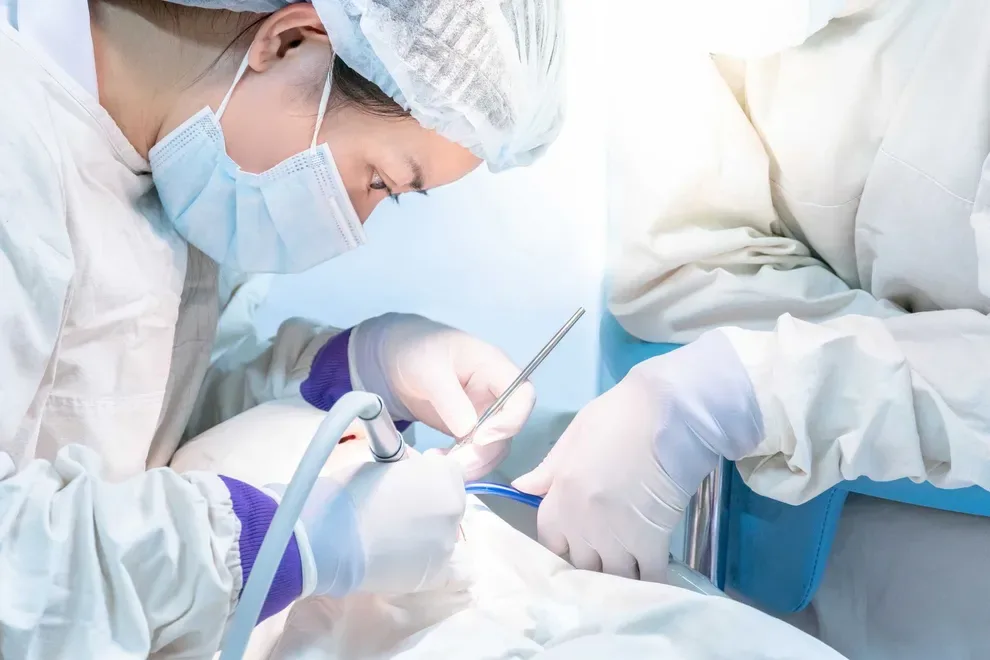Novocaine: How it Works, Side Effects, and Alternatives

Table of Contents
- Is My Dentist Using Novocaine?
- What Are Dentists Using?
- What Is Novocaine?
- How Long Does It Last?
- Risks & Side Effects
- History of Local Anesthetics
- How to Make It Wear Off More Quickly
- Frequently Asked Questions
- References
If you’ve ever been to the dentist and had a cavity filled or a tooth pulled and then walked out with your mouth feeling as if it is 10 times its normal size, you’ve probably experienced a dose of novocaine. And don’t even think about drinking water because, well, you know what can happen.
You probably think you know all you need to know about novocaine, but in fact, the more you know the better you will understand how and why it works. Join us as we explore this once popular and valuable anesthetic.
Is My Dentist Numbing My Mouth with Novocaine?
Decades ago, novocaine was the preferred option, but dentists now use other forms of anesthesia that last longer, work better, and cause fewer side effects.
What Are Dentists Using?
There are three types of dental anesthesia: local, topical, and general. Topical anesthesia comes in the form of jelly or gel applied to an area that needs numbing. This usually precedes the injection of local or general anesthesia.
Local anesthesia deactivates nerves. Lidocaine and prilocaine are the most popular form of local anesthesia currently. It is most likely your dentist is using it when preparing you for a surgery.
Of those, lidocaine is the most common with dentists using this for fillings, root canals, and extractions. General anesthesia renders patients completely unconscious. It is unlikely that your dentist will use this unless it is a major dental procedure.
There are three types of sedation, including inhalation, oral, and IV. Sedation helps calm patients, and dentists easily control the amount administered.
What Is Novocaine?
Novocaine is a local anesthetic that is injected to numb a part of the body. The drug causes a loss of feeling to the skin and mucous membranes. Medical practitioners use novocaine to numb patients and prevent pain during surgery or dental procedures.
How Long Does Novocaine Last?
Patients typically encounter the numbing effects for about an hour or two after their procedure. However, it is common to feel the side effects for up to half a day after your dental appointment.
How long novocaine lasts depends on:
The number of nerves being blocked by the numbing agent
Type of procedure performed
How long the procedure will last
Size of the area under treatment
Risks and Side Effects
The local anesthesia generally does not have significant side effects aside from the numbness. Still, people can have reactions to of novocaine, and they include:
History of Local Anesthetics
Local anesthetics started in 1884 with organic cocaine used to assist in an eye surgery. Practitioners continued using cocaine as local and regional anesthesia through the country. Soon, addiction and deaths followed the use, forcing a shift to pure cocaine in 1891.
Further developments gave rise to amino ester anesthetics such as eucaine, tropocaine, and benzocaine that came to prominence from 1891 until 1930. Similarly, amino amide local anesthetics such as novocaine, nirvaquine and lidocaine grew popular from 1898 to 1972.
Another significant development was the introduction of bupivacaine in 1957. However, it brought about cardiovascular (CV) and central nervous system (CNS) toxicity. Further research resulted in ropivacaine, introduced to the market in 1996. It has limited side effects.
How to Wear Off Novocaine More Quickly
Even though you escaped the pain of the dental procedure, facing the lingering numbing effects of novocaine can be a challenge. Typically, the numbing effect of novocaine takes about one to two hours to wear off, but you may still experience side effects up to five hours after an injection.
Here are some ways you can help the novocaine wear off more quickly:
Massage the area to increase blood flow. If you do not have pain and swelling after the procedure, gently use your fingers to massage around the site. Increased blood flow helps bring back feeling. Make sure your hands are clean before touching your mouth or face.
Use a warm compress. This is another way to increase blood flow to the area, helping the novocaine wear off more quickly.
Try some mild physical activity. If your dentist approves it, engage in light exercises like walking or riding a bike. This gets your blood pumping and flowing to the injection site, decreasing the effects of the anesthesia.
